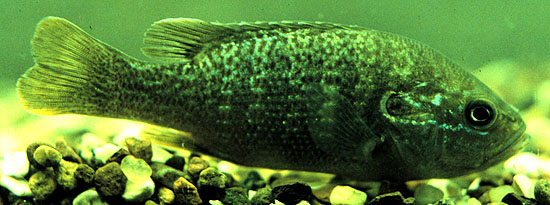
Valley Creek, Dakota County, Minnesota 20 August 1983
Green sunfish
Lepomis cyanellus Rafinesque, 1819
member of the Sunfish Family (Centrarchidae)

Valley Creek, Dakota County, Minnesota 20 August 1983
|
|
What's
In a Name? Lepomis
(Leh-poe´-miss ) means "scaled gill cover" in Greek |
||
| Where
Do They Live? Green sunfish occur in all major drainages of Minnesota. They inhabit lakes and streams of all sizes, but prefer the quiet water of shallow, weedy lakes and small streams. They can be extremely abundant in one lake and totally absent from another nearby. Green sunfish are known to gather around or in piles of brush in the water and in thick entanglements of floating vegetation. They are collected commonly with common carp, orangespotted sunfish, black crappies, spotfin shiners, and black bullheads. |
|||
|
How
Big Do They Get? |
|||
| What
Do They Eat? As do all sunfish larvae, larval greens consume copepods and waterfleas (zooplankton). Later in the year they begin to include aquatic (water) insect larvae and small snails. Larger juvenile and adult greens add small crayfish, plant material, and small fish (including their own larvae) to their diet. |
|||
|
What
Eats Them? |
|||
|
How
Do They Reproduce? |
|||
|
Conservation
and Management |
Permission is granted for the non-commercial educational or scientific use of the text and images on this Web document. Please credit the author or authors listed below.
Photographs by Konrad P. Schmidt
Text by Nicole Paulson & Jay T. Hatch in
cooperation with
the Minnesota Department of Natural Resources' MinnAqua Aquatic Program
This page developed with funds from the
MinnAqua Program
(Minnesota Department of Natural Resources, Division of Fisheries)
and the
Sport Fish Restoration
Program (Fish and Wildlife Service, US Department of the Interior)
Maintained by Jay T. Hatch
General College and James
Ford Bell Museum of Natural History
University of Minnesota, Minneapolis/St.
Paul
Last updated 25 August 2004